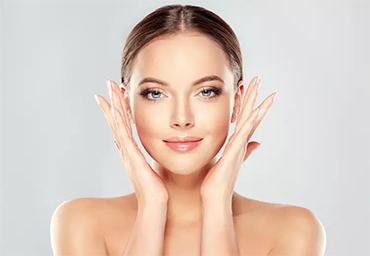
Aging causes a variety of aesthetic concerns. While many people think of wrinkles and fine lines as the main signs of aging, our skin can also become dull and rough, develop enlarged pores and become blotchy or uneven.
An uneven skin tone may be due to patches or spots of lighter or darker skin. Areas of darker skin known as age spots can dramatically age your skin and make you appear much older than you might feel. Fortunately, these spots can be easily eliminated with an innovative non-surgical aesthetic treatment called Glacial Rx™.
What Are Age Spots?
Age spots, also known as sunspots or solar lentigines, are small, dark, flat patches in the shape of ovals or circles on the skin. They are typically brown or tan but may also be gray or black.
The medical term for this condition is hyperpigmentation, as there is increased pigmentation (coloring) of the skin in these spots. Once thought to be an indicator of liver malfunction, age spots are also called liver spots. While their color may be similar to that of the liver, we have learned that liver spots aren’t actually associated with the liver and are, instead, a response to sun exposure.
What Causes Age Spots?
How Skin Pigmentation Works
Our skin contains highly differentiated skin cells called melanocytes. These cells make melanin, the pigmentation that gives our skin its color. People with melanocytes that naturally produce more melanin have darker skin, while people whose melanocytes make less melanin have lighter skin.
Sun Exposure and Melanin Production
Exposure to the sun and other forms of UV light (such as tanning beds) triggers our melanocytes to produce more melanin. While this generally results in tanned skin overall, the melanin can develop more in one area and result in groups of pigmentation that appear as age spots.
Because of this, age spots tend to develop on parts of the body that are often exposed to the sun, such as the face, chest, shoulders and hands. Unfortunately, these permanent spots on the skin don’t lighten after reduced sun exposure the way the rest of the skin loses its tan over time.
Hereditary Factors
While scientists aren’t sure exactly why the melanin groups together to form age spots, they believe genetics may play a role; those with family members who have age spots are more likely to develop them themselves.
Can Age Spots Turn into Skin Cancer?
Age spots aren’t a type of skin cancer and won’t develop into skin cancer. While they’re often aesthetically bothersome, age spots are, fortunately, not something to be concerned about health-wise.
Skin cancer can sometimes be mistaken as a harmless age spot, but you will probably be able to tell the difference by watching out for skin cancer indicators. Skin cancer spots tend to become asymmetrical, change color or become dry, painful or itchy. It’s vital to have any marks on your body like this evaluated by a dermatologist, especially if they are growing or otherwise changing.
At What Age Do Age Spots Appear?
These bothersome dark spots can appear on your skin at any age, but they tend to develop on people who are over the age of 40. However, if you spend a lot of time in the sun, you might notice that they appear on your skin in your 30s or even your 20s.
Can Age Spots Be Prevented?
Because the sun’s UV rays can’t be avoided completely, there’s no guaranteed way to prevent age spots from forming. However, there are ways to reduce the likelihood of getting them and reduce the risk of them being dark and numerous.
Using sunscreen regularly and avoiding long-term sun exposure can help reduce your chances of developing age spots. When applying your sunscreen, don’t forget to rub some into the often-neglected skin on the back of your hands to protect them from UV damage and age spots. To help prevent age spots on your face, use SPF daily and wear a hat or visor when you’ll be in the sun for more than 10 minutes.
How Do You Get Rid of Age Spots?
While there are many purported at-home remedies for age spots, most of them don’t work. And if they do make a difference in your skin, they often just lighten but don’t entirely eliminate age spots.
At California Dermatology Care, we can effectively get rid of your age spots with Glacial Rx. This non-surgical, FDA-approved treatment for age spots can restore your smooth, even skin tone and complexion without requiring any downtime after.
How Does Glacial Rx™ Treat Age Spots?
Cryogenic Age Spot Treatment
Using a patented cooling method known as Cryomodulation™, Glacial Rx administers cold temperatures to the skin through a plated handpiece. This process freezes and eliminates the excess melanin that makes up dark spots and impedes the production of additional melanin deposits in your skin. Cryomodulation also accelerates exfoliation and cellular turnover, producing new skin cells with less melanin to replace the old ones.
In this way, Glacial Rx eliminates age spots quickly and painlessly. In addition, this treatment temporarily reduces skin inflammation and redness.
Potent Skin-Brightening Serums
After the cooling plate is used, topical serums are applied to your skin with potent, nourishing ingredients. These help brighten your skin and protect it from UV and free radical damage.
Can Glacial Rx™ Prevent Future Age Spots?
Glacial Rx targets the melanin-producing melanocytes in the skin and prevents them from creating additional melanin and dark spots. However, it can’t target all of the melanocytes, leaving some that can contribute to the appearance of age spots. While this treatment can’t prevent all future age spots, it reduces the likelihood of them developing and the extent of their severity.
Get Rid of Age Spots and Smooth Your Complexion With Glacial Rx™
At California Dermatology Care in San Ramon, Hercules and Livermore, Dr. Ting and our certified providers offer Glacial Rx to treat your dark spots and rejuvenate your complexion.
To learn more or schedule your consultation, contact us online or call or text us at 925-328-0255.











 Incredible Marketing
Incredible Marketing